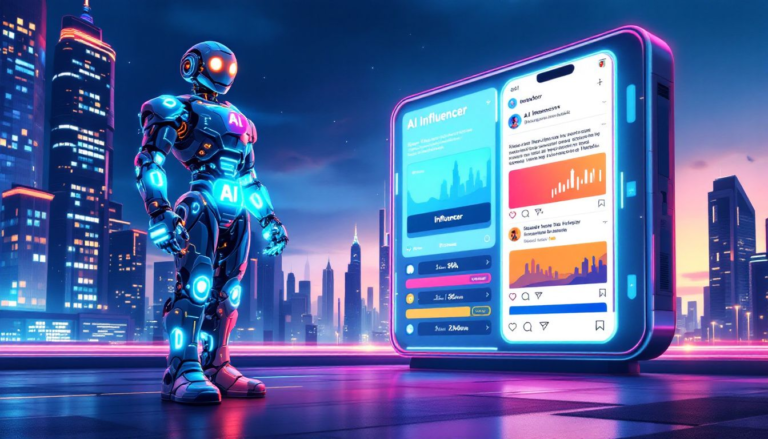The Ultimate Guide to Instagram Influencer Marketing Success
Getting the Lowdown on Instagram Influencer Marketing
Instagram influencers have become the secret sauce for brands wanting to connect with their audience and boost engagement. Let’s break down why these influencers are such a big deal and how they fit into today’s marketing game.
Why Instagram Influencers Matter
Instagram influencers are like the cool kids at school—everyone wants to know what they’re up to. They have a knack for swaying consumer choices and making people hit that “buy now” button. Did you know that a whopping 86% of social marketers say Instagram is their go-to for influencer marketing? That’s a big thumbs-up for the platform.
And get this—one out of three people on Instagram has bought something just because an influencer posted about it. That’s some serious power. Brands can ride this wave to launch new products, get their name out there, and build a fanbase.
| Metric | Value |
|---|---|
| Social marketers loving Instagram | 86% |
| Users buying from influencer posts | 33% |
| Macro-influencers’ impact | 70% |
| Micro-influencers’ impact | 43% |
Why Influencers Are a Big Deal in Marketing
Influencers aren’t just a fad—they’re a key part of marketing today, especially on Instagram. They can zero in on specific groups of people. For example, 75% of folks aged 18-24 and 67% of those aged 25-44 follow at least one influencer. This shows how influencers can reach both young adults and the middle-aged crowd.
When brands team up with influencers, they can:
- Get more eyes on their products
- Build trust and credibility
- Spark conversations and interactions
- Nudge people towards making a purchase
Instagram influencer marketing is a goldmine for brands looking to connect with an engaged audience. And if you’re curious about other platforms, check out YouTube influencer marketing, TikTok influencer marketing, and Facebook influencer marketing. Each has its own flavor of success.
By getting a handle on how Instagram influencers work, aspiring influencers can better navigate the scene and make the most of their influence.
Types of Influencers
Categorization by Follower Count
Influencers on Instagram come in five flavors based on their follower count. Each group has its own quirks, which can shape how they’re used in marketing.
| Tier | Follower Count |
|---|---|
| Nano | 0K – 10K |
| Micro | 10K – 100K |
| Mid | 100K – 500K |
| Macro | 500K – 1M |
| Mega Macro | 1M+ |
Pros and Cons of Each Tier
Knowing the ups and downs of each influencer tier helps you nail your Instagram influencer marketing.
Nano Influencers (0K – 10K)
- Pros:
- Super engaged: Nano influencers often have tight-knit communities, leading to higher engagement.
- Genuine vibes: Their messages feel more real and relatable.
- Budget-friendly: Perfect for brands with smaller wallets.
- Cons:
- Small reach: Their audience size limits how far your message goes.
- Amateur hour: Some might not have the best content production skills.
Micro Influencers (10K – 100K)
- Pros:
- Good balance: They offer a nice mix of reach and engagement.
- Niche appeal: Often cater to specific interests, great for targeted marketing.
- Cost-effective: More bang for your buck compared to bigger influencers.
- Cons:
- Moderate reach: Better than nano but still not huge.
Mid Influencers (100K – 500K)
- Pros:
- Bigger audience: They can reach a broader crowd.
- Quality content: Usually produce professional-grade content.
- Cons:
- Higher price tag: More expensive than nano and micro influencers.
- Engagement varies: Might not be as high as smaller influencers.
Macro Influencers (500K – 1M)
- Pros:
- Wide reach: They can touch a vast audience.
- Big impact: 70% of social marketers see the most impact from macro influencers.
- Polished content: They offer slick, professional content.
- Cons:
- Pricey: Working with them can be costly.
- Lower engagement: Engagement rates might dip compared to smaller influencers.
Mega Macro Influencers (1M+)
- Pros:
- Huge reach: They can connect with millions.
- Big influence: They have a lot of sway over their followers’ buying choices.
- Brand spotlight: Perfect for large-scale brand awareness.
- Cons:
- Very expensive: The priciest tier, needing big budgets.
- Lowest engagement: Engagement rates tend to be lower due to their large audience.
Each influencer tier has its own perks and pitfalls, so it’s key to match the right influencer with your campaign goals. For more tips on using different influencer platforms, check out our articles on YouTube influencer marketing and TikTok influencer marketing.
Getting the Most Out of Influencer Partnerships
Want to crush it with Instagram influencer marketing? Let’s break down what affects influencer rates and how to make those partnerships work like a charm. These tips will help you get the best bang for your buck.
What Affects Influencer Rates?
Influencer rates can be all over the place, depending on a few key things:
- Reach and Engagement: How many followers they have and how active those followers are (likes, comments, shares) play a big role. More engagement usually means higher fees.
- Content Type: Fancy videos or professional photoshoots cost more than a quick selfie.
- Campaign Length: Longer campaigns might get you a discount, but they still cost a chunk of change.
- Usage Rights: If you want to use their content in ads or other marketing, expect to pay extra.
- Influencer Tier: Rates vary based on follower count. Here’s a quick breakdown:
| Influencer Tier | Follower Count | Average Rate per Post |
|---|---|---|
| Nano | 0K – 10K | $50 – $100 |
| Micro | 10K – 100K | $250 – $450 per 10K followers |
| Mid | 100K – 500K | $1,000 – $5,000 |
| Macro | 500K – 1M | $5,000 – $10,000 |
| Mega Macro | 1M+ | $10,000+ |
Big names like Cristiano Ronaldo can charge over $3 million per post. Yep, you read that right.
How to Make Influencer Partnerships Work
To get the most out of your influencer partnerships, try these strategies:
- Clear Communication: Keep the lines open. Make sure everyone’s on the same page about goals, expectations, and deliverables.
- Mutual Benefit: Make sure both sides win. Influencers should feel valued and fairly paid, and you should get the exposure and engagement you’re after.
- Creative Freedom: Let influencers do their thing. Authentic content resonates better with their audience.
- Audience Match: Work with influencers whose followers match your target audience. This ensures your message hits the right people.
- Track Performance: Keep an eye on how the campaign is doing. Look at metrics like reach, engagement, and conversions to see what’s working.
Want more tips on influencer marketing? Check out our guides on YouTube influencer marketing and TikTok influencer marketing.
By knowing what affects influencer rates and using smart collaboration strategies, you can make your Instagram influencer marketing efforts really pay off.
Making the Most of Influencer Platforms
Instagram influencer marketing is a game-changer for brands looking to connect with their audience, introduce their brand, and build relationships with potential customers. Using influencer platforms can make this process smoother and more effective.
Why Use Influencer Platforms?
Influencer platforms offer a bunch of perks for both brands and influencers. Here’s why they’re worth it:
- Easy Collaboration: These platforms make it simple for brands and influencers to communicate and work together, keeping projects on track.
- Detailed Analytics: They provide insights into how influencers are performing, helping brands make smart decisions.
- Campaign Management: Tools for handling multiple campaigns at once save time and effort.
- Secure Payments: They ensure payments are processed safely and on time.
- Compliance Help: Platforms help make sure campaigns follow FTC rules on disclosure and authenticity.
Best Influencer Marketing Platforms
Some influencer marketing platforms really stand out, each with its own set of features. Here are some top picks:
| Platform | Key Features | Rating |
|---|---|---|
| AspireIQ | Influencer discovery, campaign management, analytics | 4.5 |
| Upfluence | Influencer search, CRM, performance tracking | 4.4 |
| Traackr | Influencer relationship management, analytics, campaign reporting | 4.3 |
| HypeAuditor | Influencer analytics, audience insights, fraud detection | 4.2 |
| Influencity | AI-driven influencer search, campaign management, reporting | 4.1 |
- AspireIQ: Great for finding influencers and managing campaigns. It offers detailed analytics to track how well your campaigns are doing.
- Upfluence: Has a strong CRM system for managing influencer relationships and advanced search tools to find the right influencers.
- Traackr: Focuses on managing influencer relationships and provides detailed reports to measure ROI.
- HypeAuditor: Specializes in analytics and audience insights, helping brands spot genuine influencers and avoid fraud.
- Influencity: Uses AI to improve influencer search and campaign management, offering detailed reports to optimize performance.
If you want to expand your influencer marketing beyond Instagram, check out platforms for YouTube influencer marketing, TikTok influencer marketing, and Facebook influencer marketing.
Using these top influencer marketing platforms, brands can boost the impact of their Instagram campaigns, connect with their target audience more effectively, and hit their marketing goals.
Influencer Marketing Strategies
Hitting the Right Crowd
Instagram influencer marketing is like a magic wand for reaching the right folks. With 75% of users aged 18-24 and 67% of users aged 25-44 following at least one influencer, hitting the bullseye with your target audience is key. Brands need to know who they’re talking to and pick influencers whose followers match that crowd.
Here’s how to nail it:
- Age Group: Zero in on influencers whose followers are in your sweet spot. If you’re after the 18-24 crowd, go for influencers who are big with college kids or young pros.
- Interests and Hobbies: Pick influencers who vibe with your audience’s interests. Fitness brand? Team up with health and wellness influencers.
- Geographic Location: If your brand is all about a specific area, find influencers from that neck of the woods to keep things relevant.
- Engagement Metrics: Check out how active and responsive the influencer’s followers are. High engagement usually means your campaign will hit harder.
| Age Group | Percentage of Users Following Influencers |
|---|---|
| 18-24 | 75% |
| 25-44 | 67% |
Want to know more about influencer marketing on other platforms? Check out our articles on YouTube influencer marketing and TikTok influencer marketing.
Making Campaigns That Click
Creating campaigns that pop is a must for getting the most out of your influencer partnerships. An engaging campaign grabs attention and gets people to act. Here’s how to make your campaigns shine:
- Authenticity: Make sure the content feels real and fits with the influencer’s style. People can spot fake endorsements a mile away, and that’s a buzzkill for your campaign.
- Storytelling: Use storytelling to weave a compelling tale around your product or service. Share personal stories, testimonials, or behind-the-scenes peeks.
- Interactive Elements: Add fun stuff like polls, quizzes, or challenges to get the audience involved. This not only boosts engagement but also gets people creating their own content.
- Clear Call-to-Actions (CTAs): Be clear about what you want folks to do. Whether it’s visiting your website, making a purchase, or joining a giveaway, a strong CTA can drive action.
- Visual Appeal: Invest in top-notch visuals to make your campaign pop. Eye-catching images and videos are more likely to grab attention and get people engaged.
For more tips on crafting campaigns for different platforms, check out our articles on Facebook influencer marketing and Twitter influencer marketing.
By focusing on the right demographics and creating engaging campaigns, brands can make the most of Instagram influencer marketing and really connect with their audience.
Keeping It Real: Compliance and Ethics in Influencer Marketing
When it comes to Instagram influencer marketing, playing by the rules is key. It’s all about being honest and upfront with your followers. The Federal Trade Commission (FTC) has laid down some ground rules to keep things transparent and trustworthy. If you want to make it big in this game, you gotta know and follow these guidelines.
FTC Rules and How to Spill the Beans
If you’re getting paid to post, you need to let your followers know. The FTC says influencers have to be clear about their brand relationships. This means no sneaky stuff—your followers should know when you’re getting paid to talk about a product.
| What You Need to Do | How to Do It Right |
|---|---|
| Be Clear | Say it in a way everyone gets. No fancy words. |
| Put It Up Front | Make sure your disclosure is easy to spot, right at the start of your post. |
| Keep It Simple | Use words like “Ad,” “Sponsored,” or “Paid Partnership.” |
| Be Honest | Even if you’re paid, tell the truth about the product. |
Messing up these rules can get both you and the brand in trouble. Want to know more about influencer marketing on other platforms? Check out our guides on YouTube influencer marketing and TikTok influencer marketing.
Keeping It Real with Your Followers
Being real is what makes influencer marketing work. People can tell when you’re faking it, and that’s a quick way to lose trust. Here’s how to keep it real:
- Pick Brands You Believe In: Work with brands that match your style and values. If you love the product, your followers will feel it.
- Tell It Like It Is: Even if you’re getting paid, give your honest opinion. Your followers will appreciate your honesty.
- Stay Consistent: Use the same words and style when you talk about your partnerships. This keeps things clear and builds trust.
Stick to these tips, and you’ll build a loyal fanbase and keep your credibility intact. Want more tips? Dive into our articles on Facebook influencer marketing and Twitter influencer marketing.







